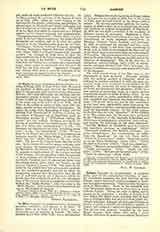

La Hire , PHILIPPE DE, mathematician, astronomer, physicist, naturalist, and painter, b. in Paris, March 18, 1640; d. in Paris, April 21, 1718; was, as Fontenelle said, an academy in himself. His father, Laurent de La Hire (1606-1656), was a distinguished artist. Philippe first studied painting in Rome, where he had gone for his health in 1660, but on his return to Paris, soon devoted himself to the classics and to science. He showed particular aptitude for mathematics, in which subject he was successively the pupil and associate in original investigation of Desargues. In 1678, he was made a member of the Academy of Sciences, section of astronomy. Beginning in 1679, in connection with the construction of a map for the Government, he made extended observations in Brittany, Guienne, Calais, Dunkirk, and Provence. In 1683, he continued the principal meridian north from Paris, Cassini at the same time continuing it south, and, in 1684, he investigated the flow and fall of the River Eure in connection with the water supply of Versailles. His attainments won for him professorships both at the College de France, in 1682, and at the Academy of Architecture. Two of his sons rose to distinction, Gabriel-Philippe (1677-1719), in mathematics, and Jean-Nicolas 685-1727), in botany. Industry, unselfishness, and piety were noteworthy traits of his character.
The chief contributions of La Hire were in the department of pure geometry. Although familiar with the analytic method of Descartes, which he followed in treatises published in 1679, his most important works were developed in the method of the ancients. He continued the work of Desargues and of Pascal and introduced into geometry, chiefly by a new method of generating comes in a plane, several conceptions related to those of recent times. In his exhaustive work on conics, published in 168-5, he not only simplified and improved the demonstrations of many well-known theorems, but he also established several new ones, particularly some concerning the theory of poles and polars, a subject not fully developed until the nineteenth century. In this work appears for the first time the term “harmonic”. Of the writings of La Hire which were, for the most part, published in the “Memoires” of the Academy of Sciences, and which treat of mathematics, astronomy, meteorology, and physics, the following are the most important: “Nouvelle Methode en Geometrie pour les sections des superficies coniques et cylindriques” (1673); “Nouveaux Elements des Sections Coniques: Les Lieux Geometriques: Les Constructions ou Effections des Equations” (in one vol., Paris, 1679); “Traite de Gnomonique” (1682); “Sectiones conicae in novem libros distributor” (Paris, 1685); “Tables du soleil et de la lune” (1687); “Ecole des arpenteurs” (1689); “Memoire sur les epicycloides” (Paris, 1694); “Tabulae astronomic” (1702); “Traite des roulettes” (1704); “Memoire sur les conchoides” (1708); “Traite de mecanique” (Paris, 1729).
PAUL H. LINEHAN

